Modern facade inspections using UAVs employ advanced drones equipped with high-resolution cameras, thermal sensors, and LiDAR technology. You'll benefit from safer, faster, and more cost-effective assessments compared to traditional methods. These drones capture detailed images and data, allowing for exhaustive analysis of building exteriors without the need for scaffolding or rope access. They can detect structural issues, energy inefficiencies, and material defects with unprecedented accuracy. Real-time streaming enables immediate decision-making, while 3D modeling provides extensive documentation. As regulations evolve, UAV inspections are set to transform the construction and maintenance industry. Discover how this cutting-edge technology is revolutionizing building assessments.
UAV Technology for Facade Inspections

The use of Unmanned Aerial Vehicles (UAVs) has revolutionized facade inspection processes. These drones offer a safer, faster, and more cost-effective alternative to traditional inspection methods. You'll find that UAVs equipped with high-resolution cameras and sensors can capture detailed images and data of building exteriors, even in hard-to-reach areas.
Modern UAVs used for facade inspections typically feature advanced stabilization systems, obstacle avoidance technology, and GPS navigation. They're capable of flying pre-programmed routes, ensuring thorough coverage of the entire building facade. You can control these drones remotely, allowing for real-time monitoring and adjustments during the inspection process.
The imaging technology on UAVs has greatly improved, with many models now featuring 4K cameras, thermal imaging capabilities, and LiDAR sensors. These tools enable you to detect structural issues, thermal leaks, and moisture problems that mightn't be visible to the naked eye.
Additionally, some UAVs are equipped with software that can stitch together multiple images to create 3D models of the facade, providing a thorough view of the building's condition.
Benefits of Drone-Based Inspections

Why are drone-based inspections gaining popularity in the construction and maintenance industries? They offer numerous advantages over traditional methods, making them an attractive option for building owners and managers.
Drones provide safer, faster, and more cost-effective facade inspections. You'll reduce the need for scaffolding, cherry pickers, or rope access, minimizing risks to workers. UAVs can quickly cover large areas, capturing high-resolution images and videos of hard-to-reach spots. This efficiency translates to significant time and cost savings.
| Benefits | Traditional Methods | Drone-Based Inspections |
|---|---|---|
| Safety | High risk | Low risk |
| Speed | Slow and labor-intensive | Fast and efficient |
| Cost | Expensive equipment rental | Lower operational costs |
You'll also enjoy improved data quality and accuracy. Drones equipped with advanced cameras and sensors can detect subtle defects that might be missed by the human eye. The collected data can be easily stored, analyzed, and shared, allowing for better decision-making and maintenance planning.
Moreover, drone inspections cause minimal disruption to building occupants and operations, making them ideal for regular inspections and monitoring of historical or sensitive structures.
High-Resolution Imaging Techniques
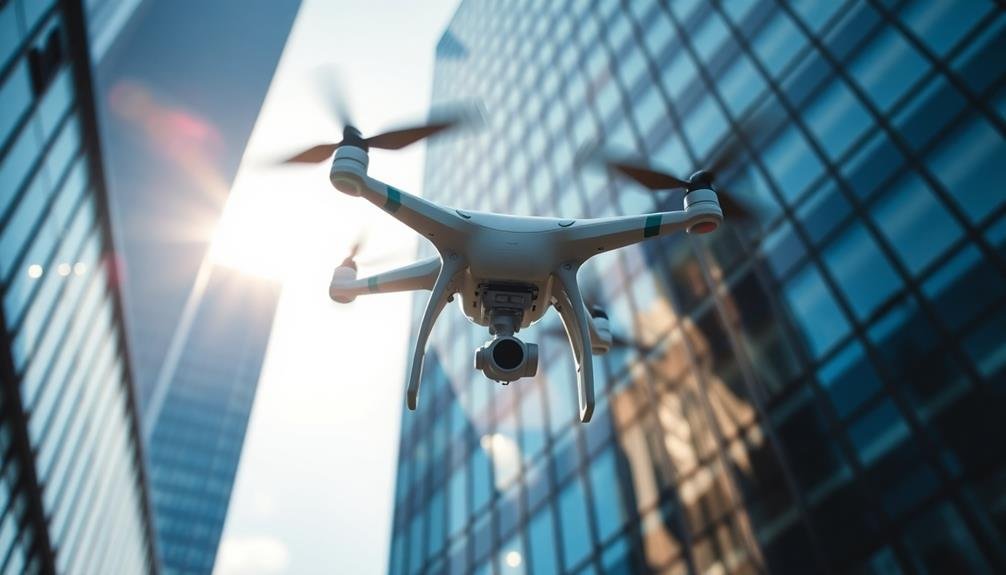
High-resolution imaging lies at the heart of effective drone-based facade inspections. You'll find that drones equipped with advanced cameras can capture incredibly detailed images of building exteriors. These cameras often boast resolutions of 20 megapixels or higher, allowing you to see even the tiniest cracks or defects when you zoom in on the images later.
Many drones used for facade inspections also feature interchangeable lenses. You can switch between wide-angle lenses for capturing entire building faces and telephoto lenses for close-up shots of specific areas of concern. Some systems even incorporate multiple cameras, enabling simultaneous capture of both visible light and thermal images.
To guarantee crisp, clear images, you'll want to use drones with gimbal stabilization. This technology compensates for the drone's movement, reducing blur and producing sharper results.
Additionally, you can employ techniques like HDR (High Dynamic Range) imaging to capture details in both shadowy and brightly lit areas of the facade. For the most thorough inspections, you might consider using photogrammetry software to stitch together hundreds of high-resolution images into a detailed 3D model of the entire building exterior.
Thermal Imaging for Facade Analysis

Thermal imaging technology integrated into UAVs revolutionizes facade inspections by revealing hidden heat anomalies.
You'll quickly identify areas of heat loss, moisture intrusion, or insulation defects that aren't visible to the naked eye.
This powerful tool allows you to assess a building's energy efficiency, pinpointing specific areas that need improvement and potentially reducing energy costs.
Heat Anomaly Detection
Cutting-edge thermal imaging technology has revolutionized facade inspection processes. By using UAVs equipped with thermal cameras, you can now detect heat anomalies that might indicate underlying issues in building facades. These anomalies often reveal problems like insulation defects, moisture intrusion, or structural weaknesses that aren't visible to the naked eye.
When inspecting facades for heat anomalies, you'll want to focus on:
- Temperature variations between different areas of the facade
- Unexpected hot or cold spots that don't align with the building's design
- Patterns of heat loss around windows, doors, or other openings
You'll find that thermal imaging is particularly useful for identifying air leaks, which can greatly impact a building's energy efficiency. By pinpointing these issues early, you're able to address them before they escalate into more serious problems.
This proactive approach not only saves money but also extends the lifespan of the building's exterior.
Energy Efficiency Assessment
Leveraging thermal imaging technology, you can conduct extensive energy efficiency assessments of building facades using UAVs.
These drones equipped with thermal cameras capture detailed heat signatures, revealing areas of energy loss and inefficiency. You'll identify heat leaks, insulation gaps, and thermal bridges that might be invisible to the naked eye.
By analyzing the thermal data, you can pinpoint specific areas where heat is escaping or cold air is infiltrating the building. This information helps prioritize repairs and improvements to enhance overall energy efficiency.
You'll detect issues like poor window seals, inadequate insulation in walls or roofs, and HVAC system inefficiencies.
The UAV-based approach offers significant advantages over traditional methods. You can quickly survey large or tall buildings, accessing hard-to-reach areas safely and efficiently.
The data collected is extensive and can be easily compared over time to track improvements or deterioration in energy performance.
With this information, you're able to develop targeted strategies for improving a building's energy efficiency, potentially leading to substantial cost savings and reduced environmental impact.
This method proves especially valuable for facility managers, energy auditors, and building owners seeking to optimize their structures' performance.
LiDAR Scanning in Architectural Surveys
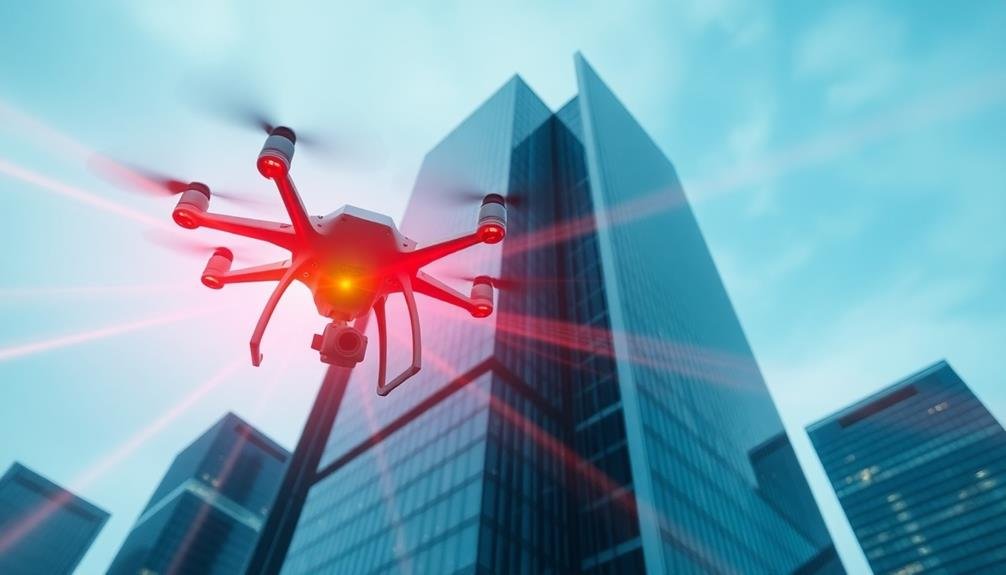
While traditional surveying methods have their place, LiDAR scanning has revolutionized architectural surveys in recent years. You'll find that LiDAR technology, when mounted on UAVs, offers unparalleled accuracy and efficiency in capturing detailed 3D models of building facades.
It's particularly useful for inspecting hard-to-reach areas and collecting extensive data in a fraction of the time it would take using conventional methods.
LiDAR scanning provides you with several key advantages:
- High-resolution point clouds that capture intricate architectural details
- Ability to detect subtle changes in surface geometry, revealing potential structural issues
- Rapid data collection, allowing for more frequent and cost-effective inspections
You'll appreciate how LiDAR data can be easily integrated into BIM (Building Information Modeling) systems, enhancing your ability to plan maintenance, renovations, or restorations.
It's also invaluable for creating accurate as-built documentation of historic structures. By combining LiDAR scanning with other UAV-based inspection methods, you'll have a powerful toolkit for thorough facade assessments.
This technology isn't just changing the game; it's redefining how we approach architectural surveys in the modern era.
Multispectral Imaging for Material Assessment
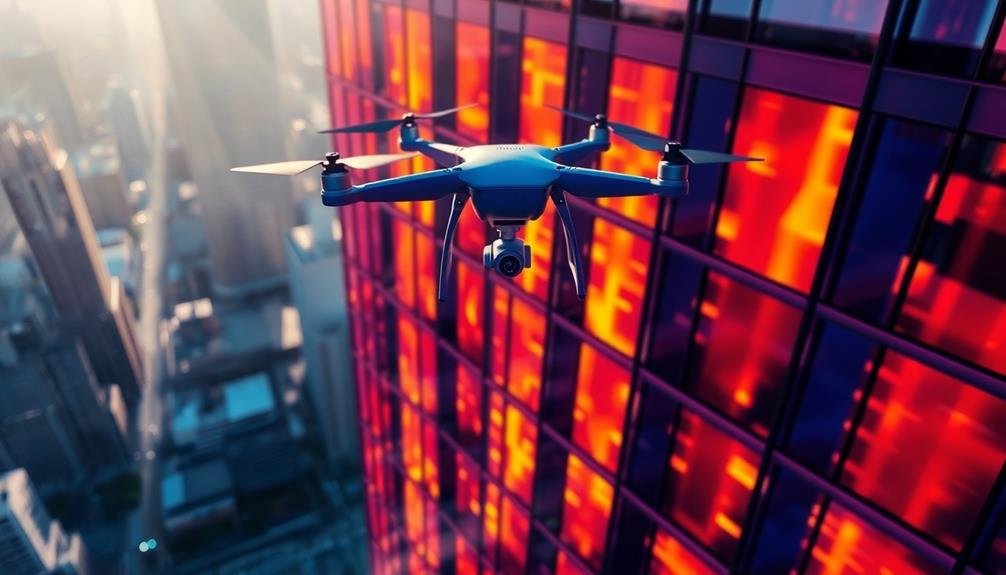
You'll find multispectral imaging to be a powerful tool for material assessment in facade inspections.
With this technique, you can detect thermal anomalies that may indicate hidden structural issues or energy inefficiencies.
Additionally, you're able to analyze material composition, helping identify deterioration, moisture infiltration, or the use of incompatible materials in past repairs.
Thermal Anomaly Detection
Equipped with multispectral cameras, UAVs have revolutionized thermal anomaly detection in facade inspections. These drones can capture infrared images that reveal temperature variations across building surfaces, allowing you to identify potential issues like insulation defects, moisture intrusion, or structural damage. By analyzing these thermal patterns, you'll pinpoint areas of concern that might be invisible to the naked eye.
To maximize the effectiveness of thermal anomaly detection using UAVs, consider these key points:
- Conduct inspections during ideal weather conditions, such as early morning or late evening, to minimize solar radiation interference.
- Use high-resolution thermal cameras with adjustable temperature ranges for accurate readings.
- Combine thermal imaging with visual and multispectral data for thorough analysis.
You'll find that thermal anomaly detection offers numerous benefits for facade inspections. It's non-invasive, time-efficient, and can cover large areas quickly.
By identifying energy inefficiencies, you can recommend improvements to reduce heating and cooling costs. Additionally, early detection of moisture-related issues helps prevent costly structural damage and mold growth.
With UAV-based thermal imaging, you're equipped to provide more extensive and accurate facade assessments, enhancing building maintenance and energy performance.
Material Composition Analysis
Three key advancements in multispectral imaging have transformed material composition analysis for facade inspections. These include improved sensor technology, enhanced data processing algorithms, and integration with AI-powered analysis tools. You'll now be able to detect subtle variations in material properties that were previously invisible to the naked eye.
Using UAVs equipped with multispectral cameras, you can capture images across various wavelengths of light. This allows you to identify different materials, assess their condition, and detect potential issues like moisture intrusion or material degradation. The data collected can be analyzed to create detailed maps of a building's facade composition.
Here's a breakdown of common wavelengths used in multispectral imaging for facade inspections:
| Wavelength | Range (nm) | Applications |
|---|---|---|
| Visible | 400-700 | Color analysis, surface defects |
| Near-IR | 700-1400 | Moisture detection, material identification |
| Short-wave IR | 1400-3000 | Thermal properties, chemical composition |
AI-Powered Defect Detection Systems
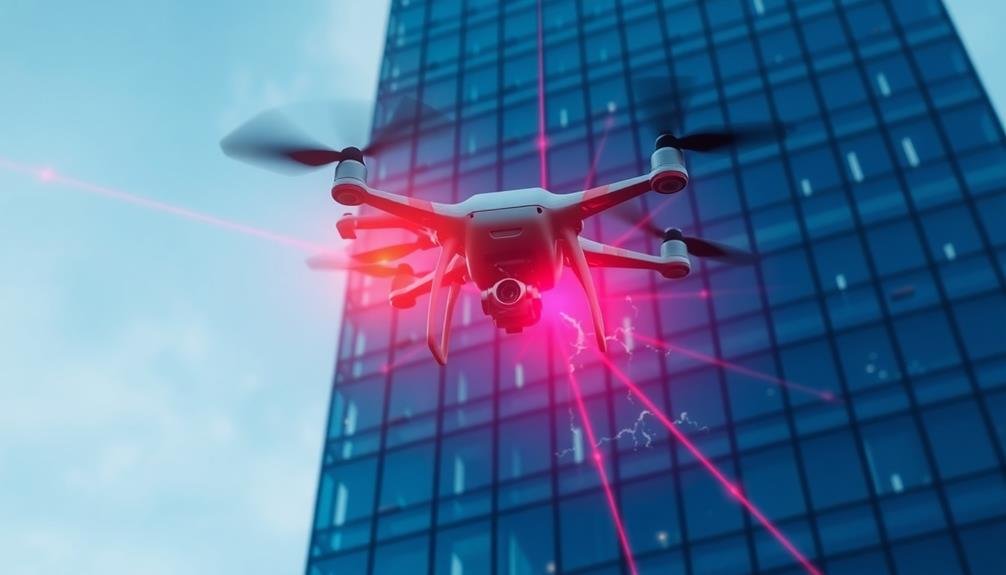
Increasingly, AI-powered defect detection systems are revolutionizing facade inspection processes using UAVs. These advanced systems utilize machine learning algorithms to analyze high-resolution images and data collected by drones. You'll find that AI can identify and classify various defects, including cracks, spalling, corrosion, and water damage, with remarkable accuracy and speed.
By incorporating AI into your facade inspection workflow, you'll experience several benefits:
- Increased efficiency: AI systems can process vast amounts of data quickly, reducing inspection time and costs.
- Enhanced accuracy: Machine learning models can detect subtle defects that might be missed by human inspectors.
- Consistent results: AI eliminates human bias and fatigue, guaranteeing uniform inspection quality across large projects.
You'll need to train the AI models on a diverse dataset of facade defects to guarantee peak performance. As you collect more data over time, the system's accuracy will improve.
It's crucial to recognize that while AI-powered defect detection is highly effective, it's best used in conjunction with human expertise for final decision-making and interpretation of results.
3D Modeling From Drone Data
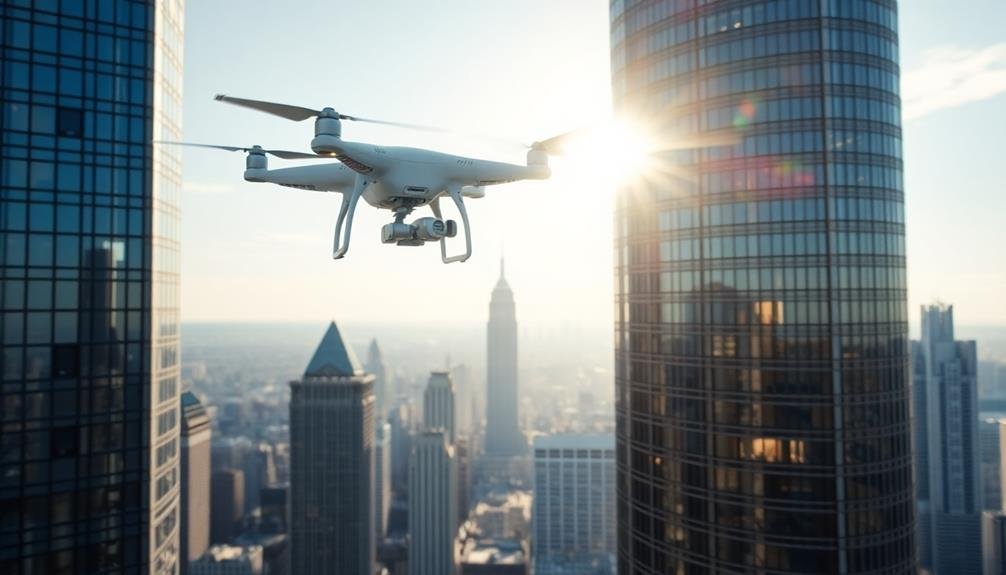
You'll find that 3D modeling from drone data revolutionizes facade inspection through photogrammetry and point cloud generation.
These technologies enable you to create detailed digital replicas of buildings, which can be seamlessly integrated into Building Information Modeling (BIM) systems.
Photogrammetry and Point Clouds
Photogrammetry's power lies in its ability to transform drone-captured images into detailed 3D models of building facades. This technique uses overlapping photos taken from different angles to create accurate digital representations of structures.
As you fly your drone around a building, it captures hundreds of images that software then stitches together, forming a thorough point cloud.
Point clouds are dense collections of data points in 3D space, each representing a specific location on the facade's surface. These clouds provide precise measurements and can reveal subtle details that might be missed during traditional inspections.
You'll find that point clouds are incredibly versatile, allowing you to:
- Detect structural issues like cracks, bulges, or misalignments
- Measure dimensions and calculate surface areas accurately
- Create textured 3D models for virtual walkthroughs and presentations
BIM Integration Capabilities
BIM integration opens up a world of possibilities when it comes to leveraging drone-captured data. You can seamlessly incorporate UAV-collected information into your Building Information Modeling (BIM) workflows, enhancing the accuracy and efficiency of your facade inspections. This integration allows you to create detailed 3D models of building exteriors, which you'll use for various purposes, from maintenance planning to renovation projects.
When you combine drone data with BIM, you'll benefit from:
| Advantage | Description |
|---|---|
| Precision | Accurate measurements and details |
| Visualization | Enhanced 3D representation |
| Collaboration | Improved teamwork and data sharing |
| Time-saving | Faster updates and modifications |
| Cost-efficiency | Reduced need for on-site visits |
Defect Detection Algorithms
Cutting-edge defect detection algorithms are revolutionizing the way we analyze drone-captured facade data. These algorithms can quickly process vast amounts of visual information, identifying potential issues that might be missed by human inspectors.
You'll find that machine learning and computer vision techniques are at the heart of these systems, enabling them to recognize patterns and anomalies in building surfaces.
When you're using defect detection algorithms for facade inspections, you'll benefit from:
- Automated crack detection and measurement
- Identification of moisture issues and water damage
- Recognition of material degradation and corrosion
These algorithms can analyze both 2D images and 3D point clouds generated from drone data. They're capable of detecting subtle changes in texture, color, and geometry that might indicate structural problems.
You'll be able to create detailed reports highlighting areas of concern, complete with precise measurements and location data. As these algorithms continue to improve, they're becoming increasingly accurate at distinguishing between different types of defects and evaluating their severity.
This technology is making facade inspections more efficient, cost-effective, and thorough than ever before.
Real-Time Streaming and Inspection

Leveraging advancements in wireless technology, real-time streaming and inspection have revolutionized UAV-based facade assessments. You can now monitor building inspections as they happen, receiving high-definition video feeds directly from the drone to your ground control station or mobile device. This immediate access allows you to make on-the-spot decisions and adjustments to the inspection process.
Real-time streaming enables you to guide the UAV operator more effectively, focusing on areas of concern as they're discovered. You'll benefit from reduced inspection times and increased efficiency, as you can identify issues and direct further investigation without waiting for post-flight data analysis.
Modern UAV systems often incorporate 5G technology, ensuring minimal latency and high-quality video transmission. You can even use augmented reality overlays on the live feed, highlighting potential defects or comparing current conditions to previous inspections.
With real-time inspection capabilities, you're able to involve remote experts in the assessment process. These specialists can provide instant feedback and recommendations, enhancing the overall quality and accuracy of your facade inspections.
This collaborative approach greatly improves decision-making and helps you address critical issues promptly.
Regulatory Considerations for UAV Inspections

As you navigate the world of UAV-based facade inspections, you must be aware of the regulatory landscape governing drone operations. Different countries and regions have their own set of rules and requirements for commercial drone use. In the United States, for example, the Federal Aviation Administration (FAA) oversees UAV operations and enforces regulations such as obtaining a Part 107 license for commercial drone pilots.
When planning your facade inspection using UAVs, consider these key regulatory aspects:
- Airspace restrictions and no-fly zones
- Privacy laws and property owner consent
- Insurance requirements and liability coverage
You'll need to obtain necessary permits and clearances before conducting inspections, especially in urban areas or near sensitive locations.
It's essential to stay updated on changing regulations, as drone laws are continually evolving. You should also implement safety protocols and risk assessment procedures to guarantee compliance with local and national guidelines.
Future Trends in Facade Inspection

The facade inspection industry is rapidly evolving, with new technologies and methodologies emerging to enhance efficiency and accuracy.
You'll see AI and machine learning playing a larger role in analyzing inspection data, allowing for faster and more precise defect detection. These systems will learn from vast databases of facade issues, becoming increasingly adept at identifying potential problems.
Expect to see more advanced sensors integrated into UAVs, including thermal imaging, LiDAR, and hyperspectral cameras. These will provide a more thorough assessment of building facades, detecting issues invisible to the naked eye.
You'll also witness the rise of autonomous inspection drones that can navigate complex urban environments and perform routine inspections without human intervention.
Virtual and augmented reality technologies will revolutionize how inspection results are visualized and communicated. You'll be able to immerse yourself in 3D models of inspected buildings, exploring details and potential issues in a highly interactive manner.
Additionally, blockchain technology may be employed to guarantee the integrity and traceability of inspection data, providing a tamper-proof record of building conditions over time.
Frequently Asked Questions
How Do Weather Conditions Affect Uav-Based Facade Inspections?
You'll find weather greatly impacts UAV facade inspections. Wind can destabilize drones, affecting image quality. Rain or snow obscures visibility. Extreme temperatures may affect battery life. Always check conditions before flying for best results.
What Training Is Required for Operators of Facade Inspection Drones?
You'll need UAV pilot certification and training on facade inspection techniques. You should learn about building materials, defect identification, safety protocols, and data analysis. Specialized courses in architectural inspections are also beneficial for your expertise.
How Does UAV Inspection Compare to Traditional Methods in Terms of Cost?
You'll find UAV inspections are often more cost-effective than traditional methods. They're faster, require less equipment, and reduce labor costs. You won't need expensive scaffolding or lifts, saving you both time and money on facade inspections.
Can UAVS Inspect Interior Spaces of Buildings as Well as Exteriors?
You can use UAVs to inspect building interiors, but it's more challenging. They're great for large open spaces like warehouses or atriums. For smaller rooms, you'll face obstacles like tight spaces and potential signal interference.
What Are the Data Storage and Management Challenges for Large-Scale Facade Inspections?
You'll face challenges with massive data volumes from UAV inspections. You're dealing with high-res images, 3D models, and sensor data. You'll need robust storage systems, efficient data management tools, and secure cloud solutions to handle it all effectively.
In Summary
You've seen how UAVs revolutionize facade inspections with advanced imaging, thermal analysis, and 3D modeling. They're making the process safer, faster, and more accurate. As technology evolves, you'll witness even more sophisticated drones and AI-assisted inspections. Remember to stay updated on regulations as you embrace these tools. The future of facade inspection is here, and it's flying high with unmanned aerial vehicles leading the way.

As educators and advocates for responsible drone use, we’re committed to sharing our knowledge and expertise with aspiring aerial photographers.
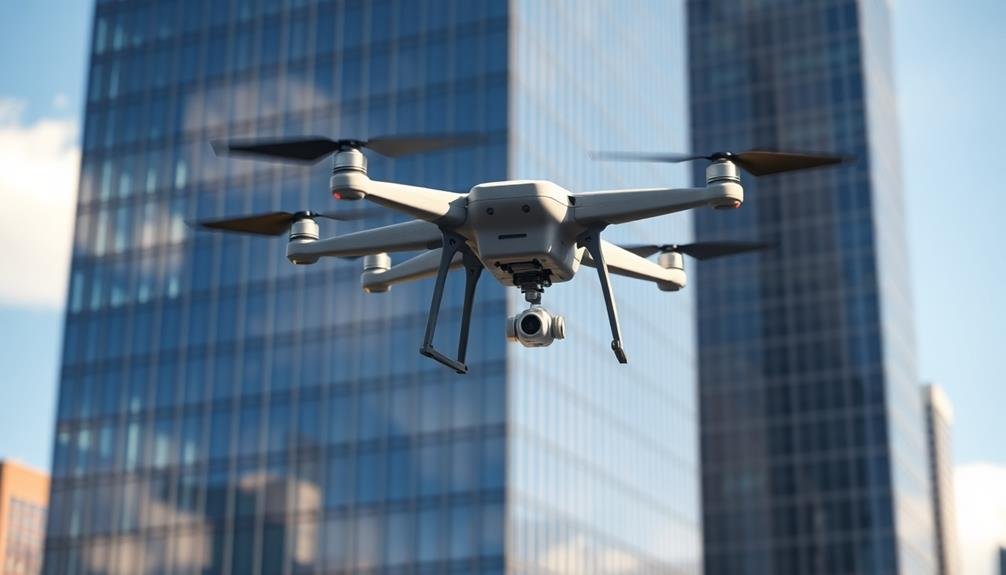



Leave a Reply